'The cavalry hasn't arrived': Somalia on the brink of famine
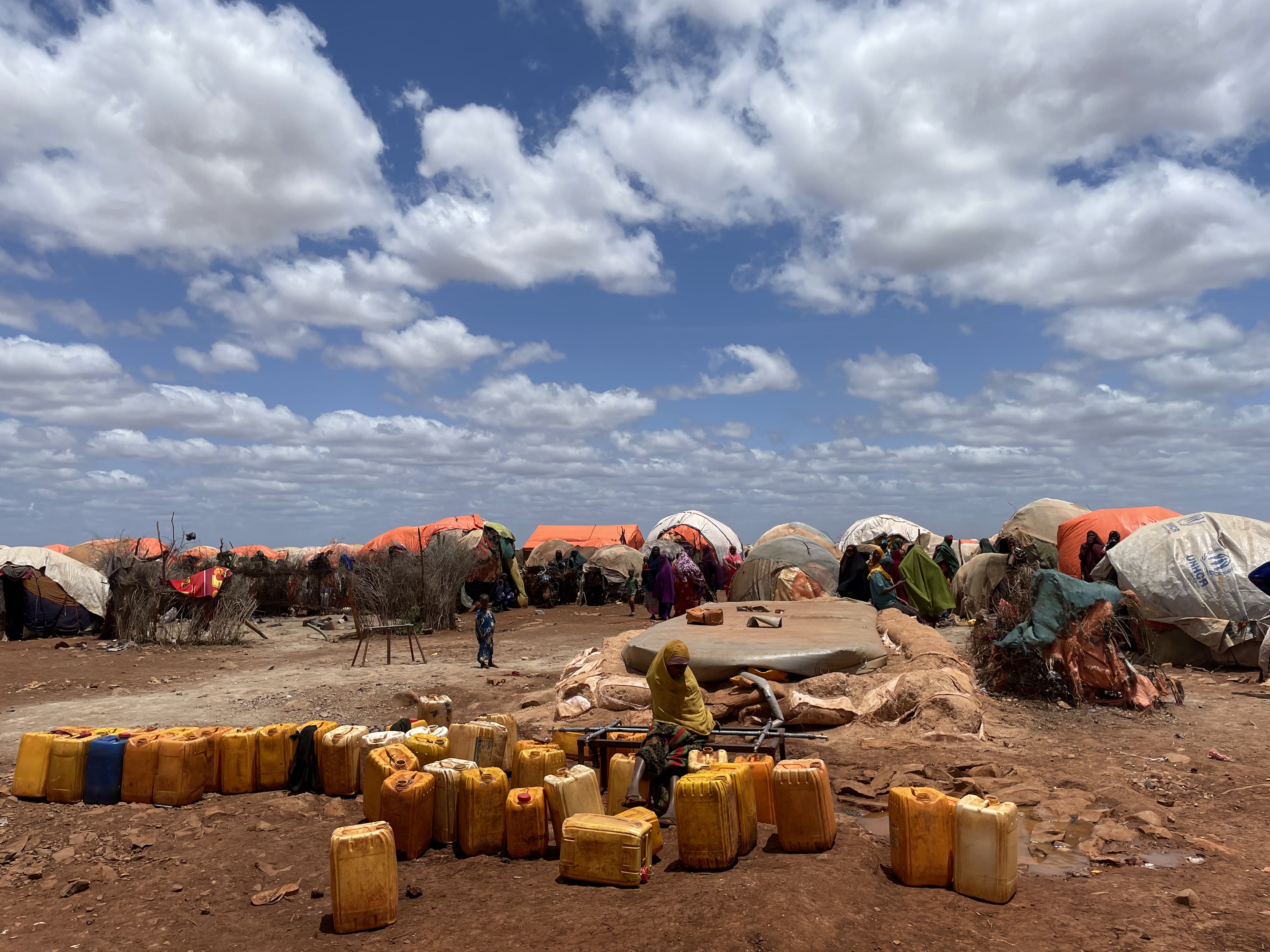
BAIDOA, Somalia — While she loves all her eight grandchildren, Sontoy Mursal says Abdullahi was her favorite. He was the one who would respond to her when she called for help — running to her side to lessen his grandmother’s burden while the others continued playing. The boy was sweet and polite — the two of them shared a special bond, she says.
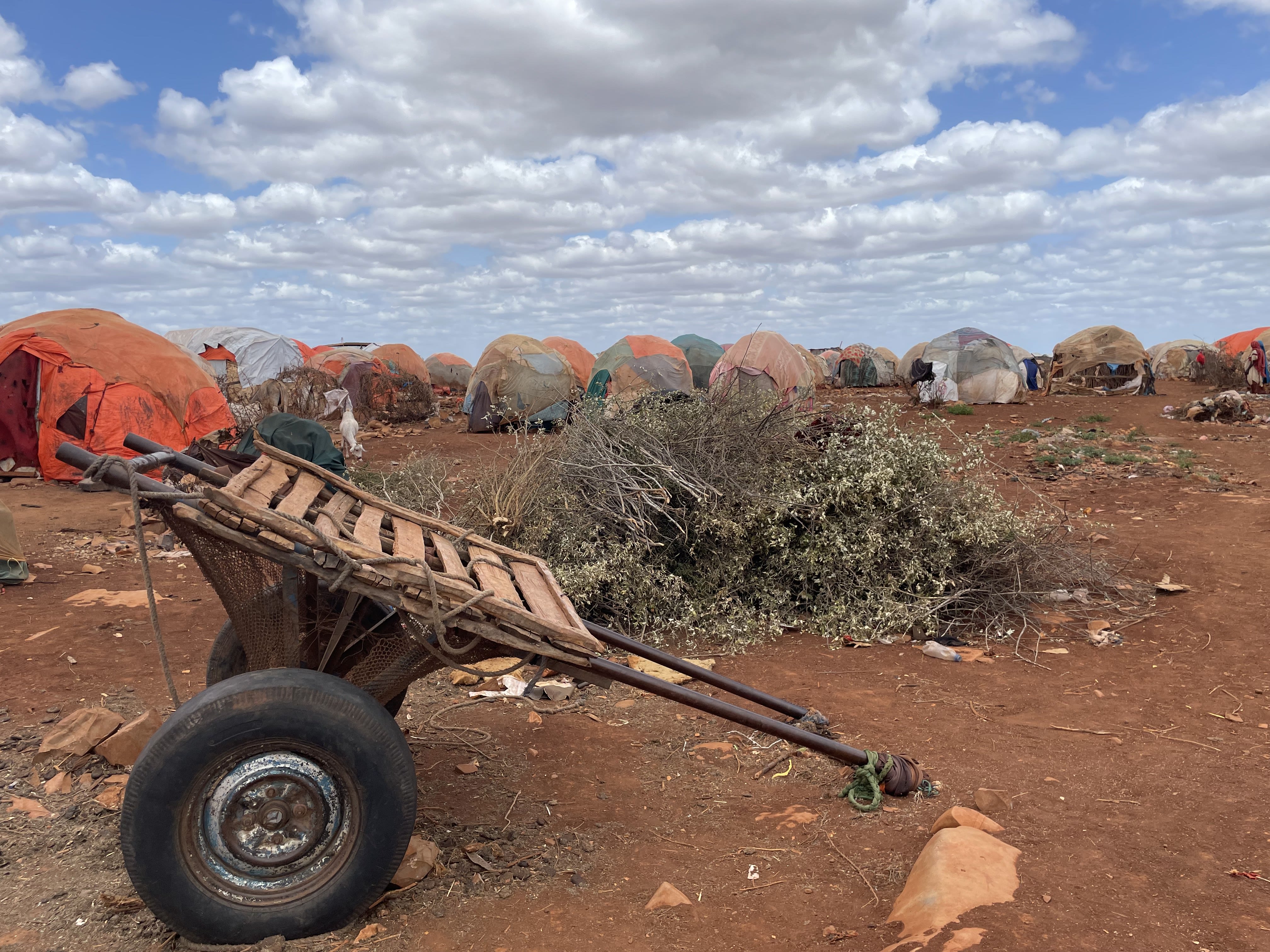
A donkey cart at a displacement camp in Baidoa.
A donkey cart at a displacement camp in Baidoa.
Sontoy comes from a farming area in southern Somalia. When the rains repeatedly failed and the movement of goods into her village was restricted by the militant group al-Shabab, her family had nothing. They heard help was available in the city of Baidoa, so they set out with a donkey cart on a journey of 60 miles (about 100 kilometers) — a brutal trek that took two weeks. She made this journey several months ago with four of her orphaned grandchildren and her widowed daughter with her four children.
Abdullahi died from starvation during the journey, and Sontoy was forced to bury the 6-year-old on the side of the road.
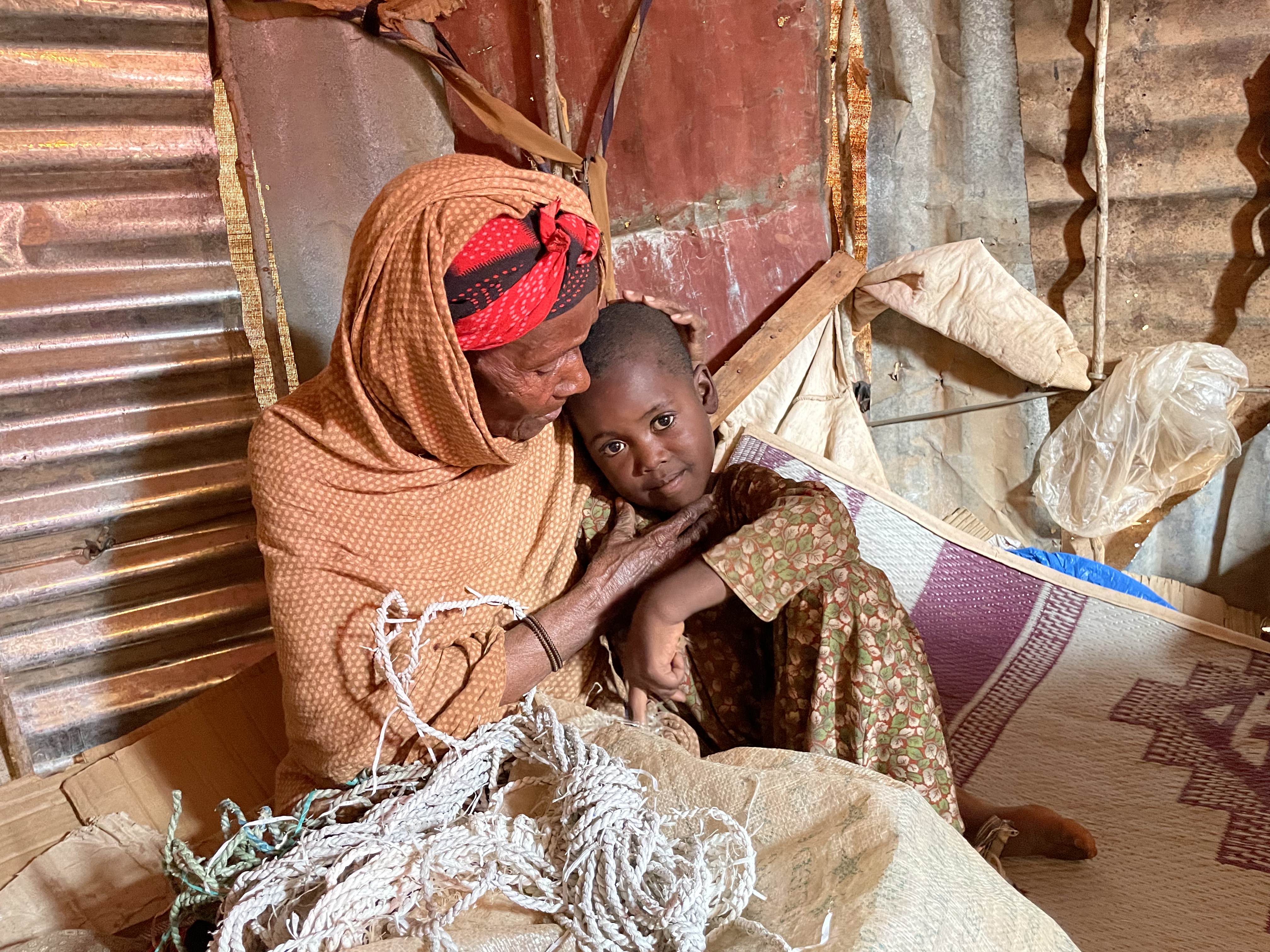
Sontoy Mursal and her granddaughter.
Sontoy Mursal and her granddaughter.
She now lives with a broken heart in a crowded displacement camp with few services. A 70-year-old grandmother — with a brood of grandchildren and her daughter relying on her for support.
“I've heard of mothers who left some of their children to save the others.”
Thirty-year-old widow Keerey Ibrahim Idris lives in a camp not far from Sontoy. She also mourns the recent death of her two children.
When her crops withered away, hunger pushed her and her 10 children on a three-day journey without shoes to Baidoa. The day after they arrived, her 9-year-old daughter, Atar, collapsed and died from starvation. Two months later, Suheyba, her 2-year-old daughter who had malnutrition, died of measles. Keerey buried her two children on someone’s private land. She has no idea who it belongs to.

Thirty-year-old widow Keerey Ibrahim Idris lives in a camp in Baidoa.
Thirty-year-old widow Keerey Ibrahim Idris lives in a camp in Baidoa.
Four rainy seasons in a row have failed in the Horn of Africa since late 2020, a climatic event not seen in at least 40 years. The chances are high that the next rainy season, expected to start in October, will also fail, which would be unprecedented. Exacerbating an already dire situation, the war in Ukraine has caused food prices to spike; the cost of a food basket in East Africa has risen 49% in the past year.
Over 7 million people in Somalia — nearly half of the population — need urgent assistance for acute malnutrition and at least 330,000 children need treatment for the deadliest form of malnutrition. The country now has one million people who are displaced. Over 755,000 were displaced this year because of the drought.
The United Nations said Monday that “famine is at the door” and is expected to occur in the Bay region, including Baidoa and Burhakaba districts, between October and December. Three numerical thresholds defining the disaster must be met before an official declaration — and it is also considered a highly political process. But those responding to the crisis suspect famine might have already arrived.
"We are seeing the telltale signs of full-blown famine,” said Daud Adan Jiran, Mercy Corps country director for Somalia.
THE 'TWO TERRIBLES'
Somalis have a tradition of naming droughts. This one is called Sima or the Equalizer.
"It has made everybody poor — whether you are an agriculturalist or a pastoralist; whether you owned 100 heads of cattle, or you owned 10. The loss is the same," Jiran said.
The international community has largely ignored the early warning sirens, and a delayed presidential election held in May distracted Somali politicians, sidelining leadership and advocacy around the response.
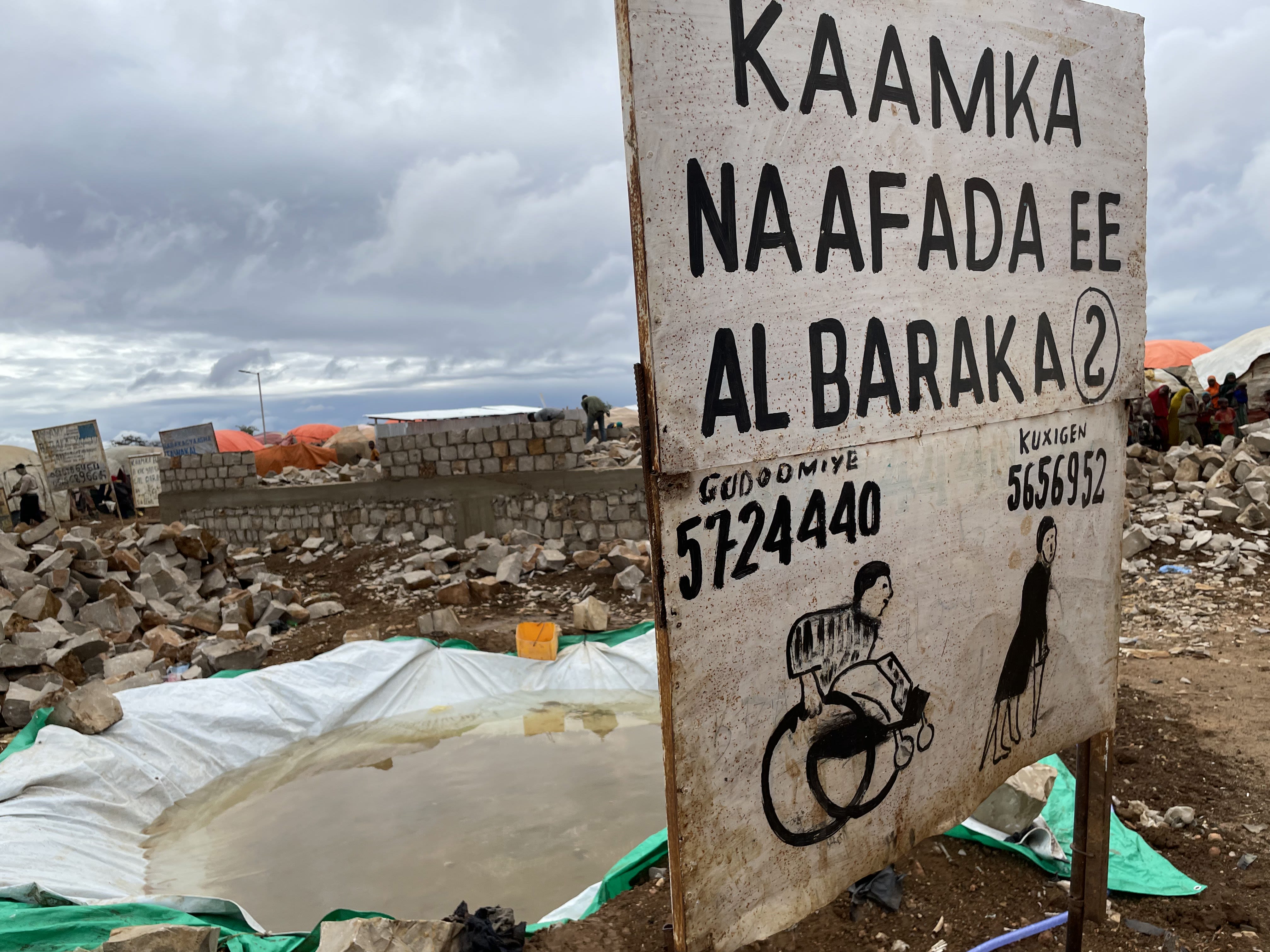
A displacement camp where people with disabilities have settled.
A displacement camp where people with disabilities have settled.
Navigating a response is also incredibly complex. Al-Shabab controls large swaths of southern and central Somalia, which limit the reach of government and humanitarian groups.
“What we've seen is bad but I also recognize it's likely the tip of the iceberg. I'm even more concerned about those who are left behind and communities who couldn't make the trip, and the lack of support they're getting,” said Tjada D'Oyen McKenna, CEO at Mercy Corps.
Livestock has died in droves and crops have withered, forcing rural populations to choose between the “two terribles,” said Jaafarsadiq Hassan, deputy chief of party at Mercy Corp Somalia.
"If I stay, I will end up dying here. But if I go and take my chances, I also may die along the way. And If I reach there, I'm not sure whether I will still get enough help,” he said. "Every decision is terrible, so let me just pick one.”
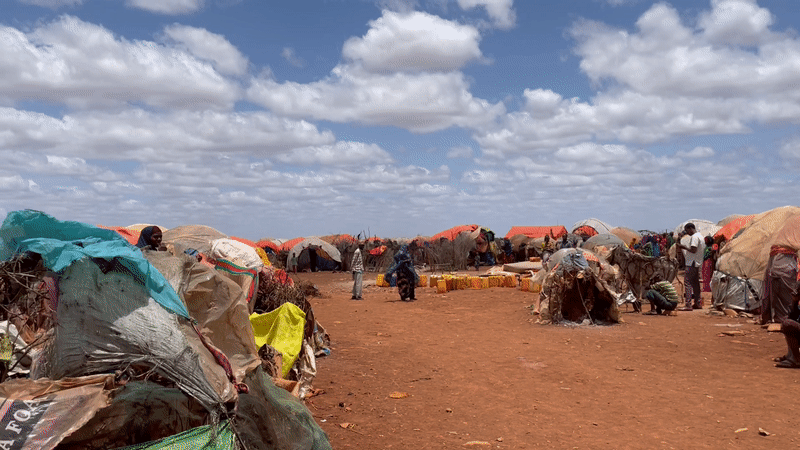
A displacement camp in Baidoa.
A displacement camp in Baidoa.
Somalis have fled en masse to urban areas — needing urgent assistance on arrival. Hassan said he’s heard of families walking 30 days to reach Baidoa.
“People don't have enough access to food on the journey,” Hassan said. “They come with emaciated body weights that are very, very alarming.” There are many cases of marasmus and kwashiorkor — severe cases of malnutrition — among arrivals. Many mothers are too malnourished to breastfeed.
"I've heard of mothers who left some of their children to save the others,” Jiran said. "A child wandered away but because the others were so hungry, she had no time to look for that missing child. She had to keep on walking to bring the others to safety."
People make their own tents, cobbled together with branches, tarps, and pieces of cloth, creating new settlements. The humanitarian response is not keeping pace with the influx of people.
One community, for example, survives by hunting dik-diks. When these small antelopes died off, the community trekked to Baidoa. After settling, it took responders two months to find their camp and establish minimal services, including water trucking.
“We have reached the threshold of famine. … We need money. We need services today. We don't need talking.”
Many of the camps don’t receive food distributions — people get what they can through borrowing, handouts from neighbors, and whatever money is earned from casual work, such as shining shoes in town. And even then, it's often a meal of plain rice or maize. Water trucking is minimal. Many walk long distances to the camps where it's trucked in, wait in long queues to fill their cans, and sometimes don't even receive it.

Seventy-seven year-old Mukhtar Haji Abukar lives in a displacement camp in Baidoa.
Seventy-seven year-old Mukhtar Haji Abukar lives in a displacement camp in Baidoa.
Seventy-seven-year-old Mukhtar Haji Abukar, whose beard and hair are stained orange by henna, sits in his hut on the last remnant of his livestock — a cowhide. He once grew crops and had 60 goats, camels, and cows. Nothing is left. He was told in Baidoa that he would find planes dropping money from the sky. Instead, he lives in a camp with little support.
A man at a camp in Mogadishu said he knew two men who killed themselves because they couldn’t provide for their families. Other women tell of husbands abandoning them.
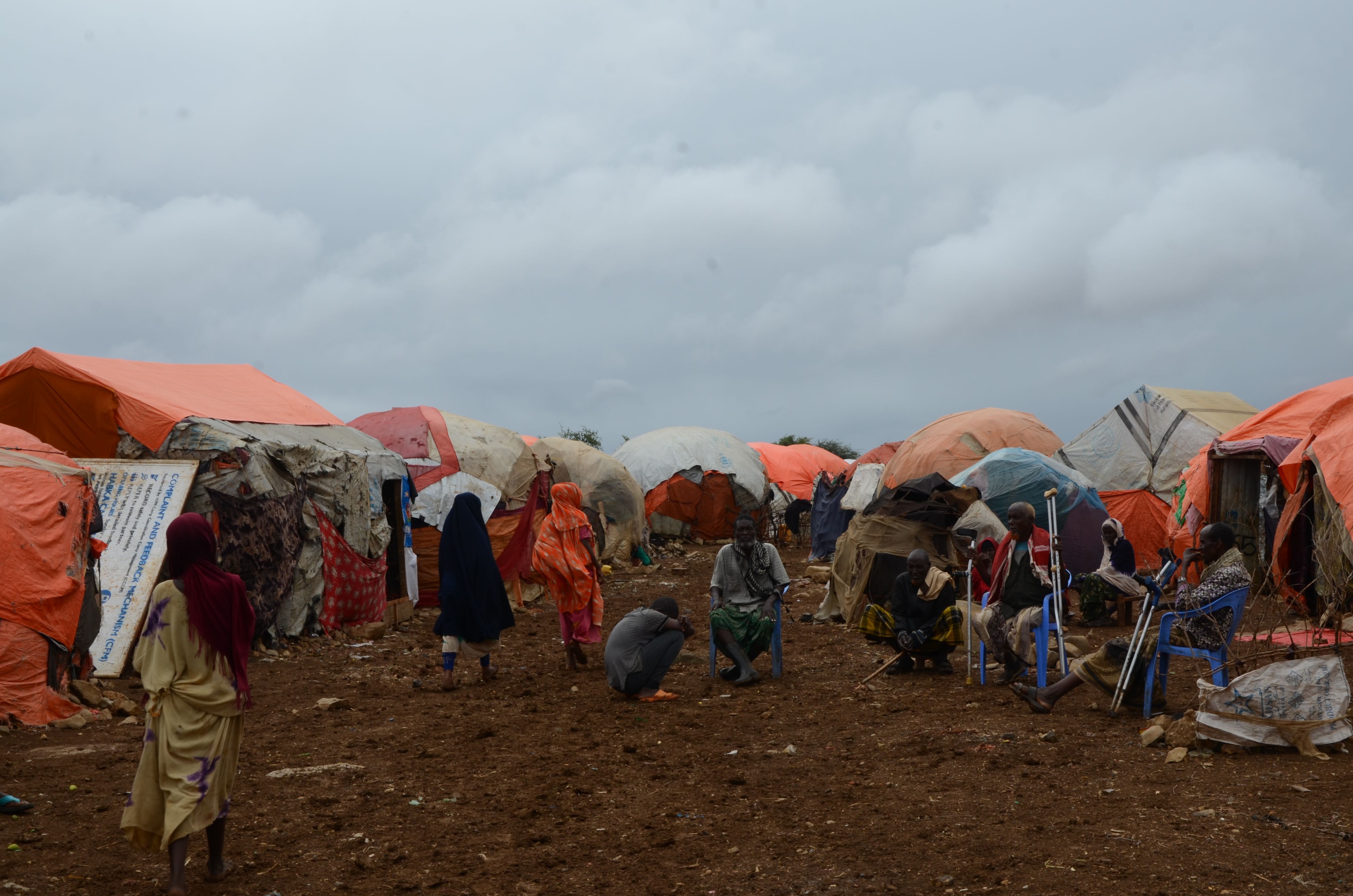
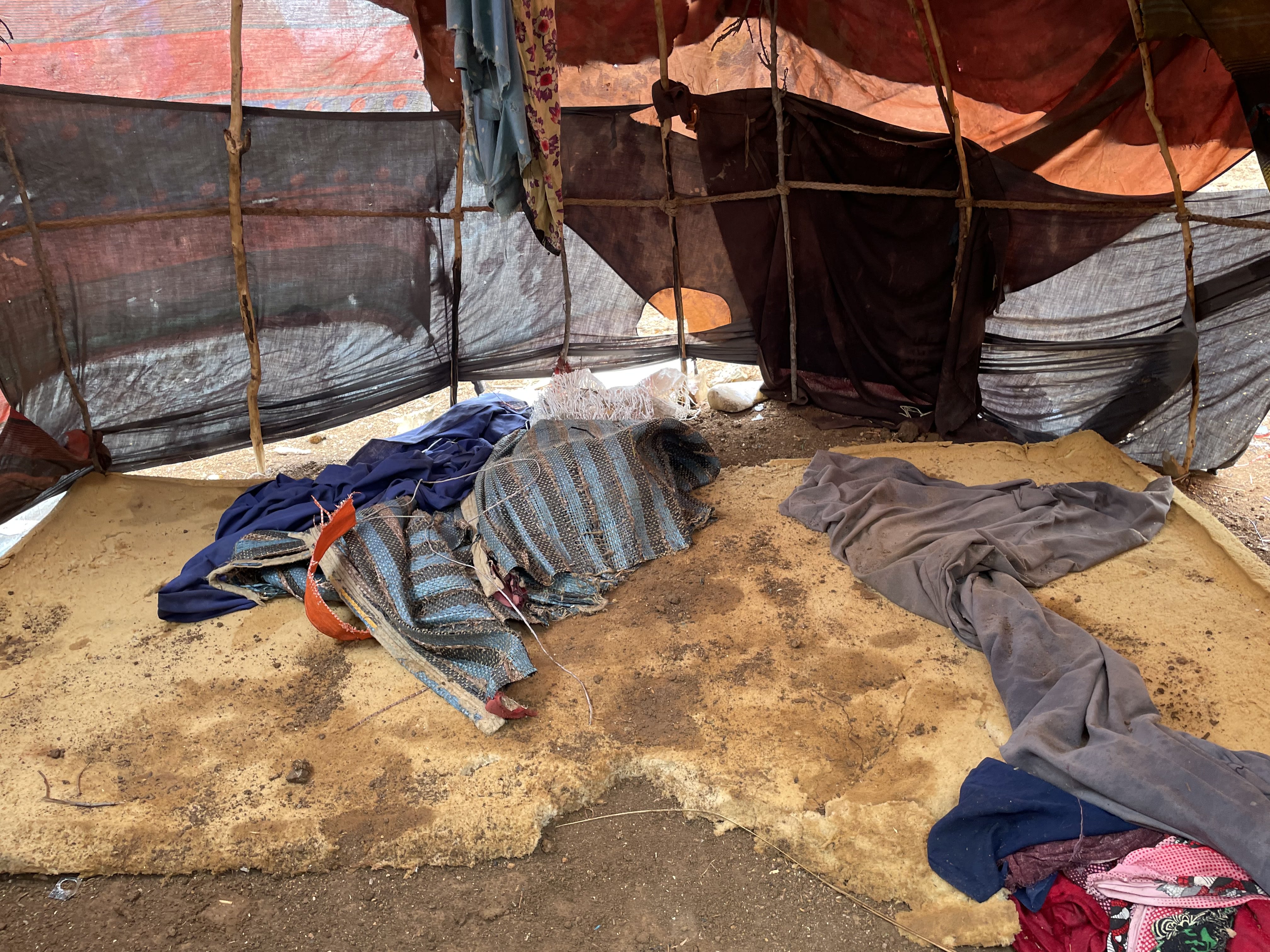



Inside a hut in a displacement camp in Baidoa.
Inside a hut in a displacement camp in Baidoa.

Tents at a displacement camp in Baidoa.
Tents at a displacement camp in Baidoa.
‘We saw babies being buried’
Bashir Said Hassan walks through the halls of Baidoa District Hospital with urgency, speaking above a chorus of crying babies. He’s a program director at SOS Children’s Villages Somalia.
“People are dying because there's no food,” he said. “The last two days, I was traveling with the team. We saw babies being buried. It hurts. It's raw.”
The hospital used to see around 200 patients per day for health and nutrition services, now it sees at least 500, said Dahir Mayow, senior project officer in health and nutrition at SOS.
At the hospital’s nutrition center, mothers crowd with babies in their arms, waiting to have them weighed and measured. Health staffers keep a tally of malnourishment cases on a poster mounted to the office wall. It tells the story of a rapidly escalating crisis.

A woman holds her severely malnourished child at a health clinic.
A woman holds her severely malnourished child at a health clinic.
In February, the hospital admitted 125 children into outpatient therapeutic programs. In July, that number reached 561 — a 120% spike from the previous month.
In South West state, where Baidoa is located, the acute malnutrition threshold for famine has surpassed, with death rates reaching emergency thresholds, government officials said. An estimated 53% of the 213,000 people currently at risk of famine in the country are in this region.
SOS has worked at the hospital since 2008. Mayow said that in recent months they’ve seen the highest number of malnourishment and edema — swelling caused by malnutrition — cases. They had 71 cases of edema in July alone, whereas in March there were only three.
"Organizations are prioritizing the most vulnerable. … [But] trying to sort out who is the most vulnerable from the other is a nightmare."
UNICEF supports the facility with nutritional therapy but sometimes there are shortages, Mayow said.
"Our previous daily target was five cases but imagine we sometimes enroll 50 children in a day into the malnourishment program," Mayow said.
Malnourishment weakens immunity, making people susceptible to other diseases. Nearly 12,000 suspected cases of measles were reported this year through July in the country over 9,200 cases of cholera through mid-August. A camp manager in Mogadishu said that 18 children died in the past month and a half in their community, mostly from measles.
Ubah Abbas Abdullahi, walked from a camp two hours away to get to the Baidoa District Hospital — it's the closest health center to the camp where she stays. Her 7-month-old baby has been ill for four months, but it’s the first time she brought her in. She is severely malnourished with a skin infection. Ubah received a bag of nutritional therapy, a peanut-based paste for the baby to suckle.
"Some of them don’t have the information about where the services are available. And the majority don't have the means of transport and do not know the city because they're coming from rural locations,” Said Hassan said.
As he moves through the hospital, Said Hassan pointed to an old man lying in a fetal position, malnourished to the point that he is skeletal. He was picked up by SOS mobile teams and brought in.
The hospital frequently sees cases of malnourished adults but doesn't have the right treatment for them.
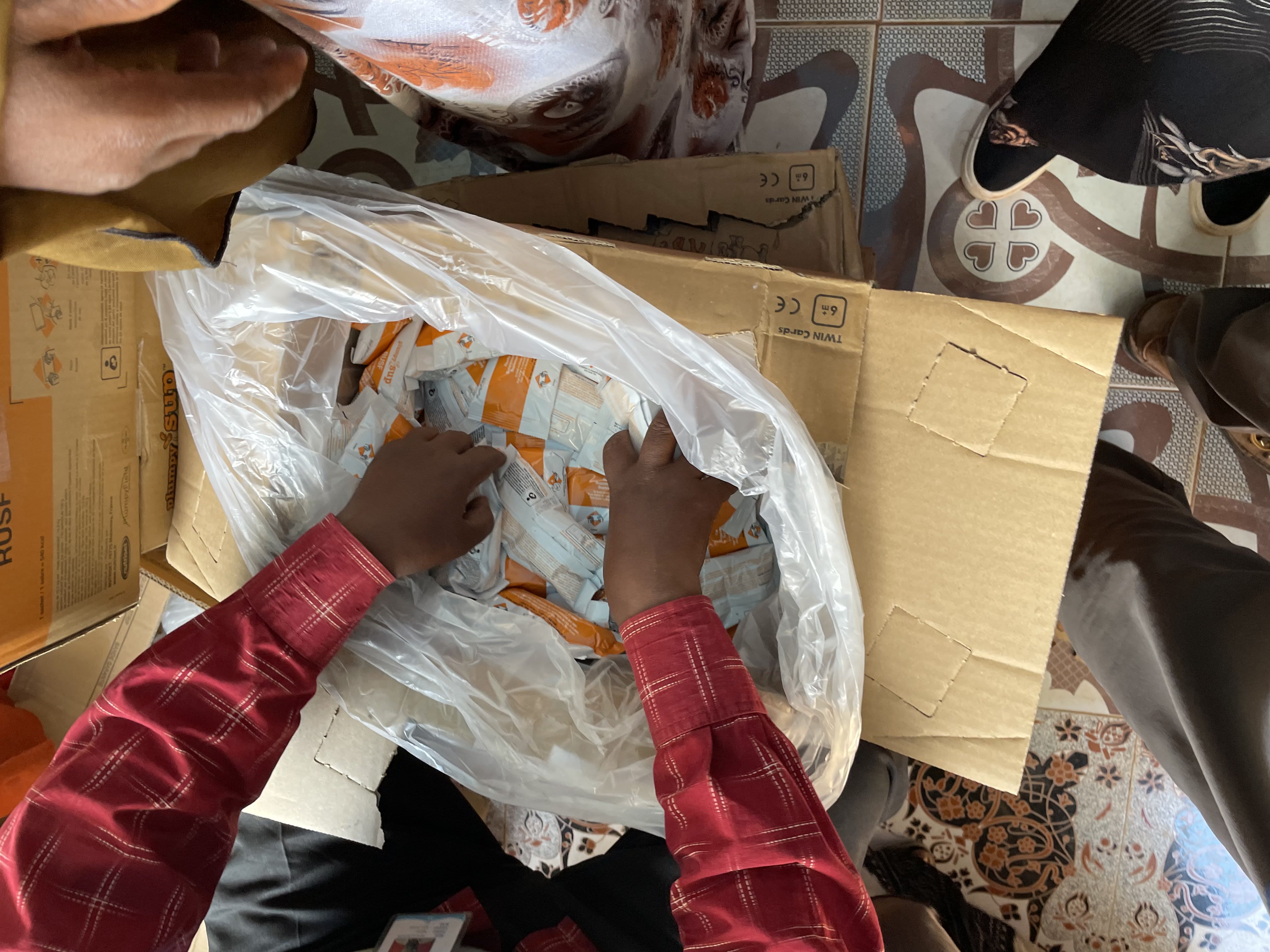
A distribution of nutritional therapy for children with malnourishment.
A distribution of nutritional therapy for children with malnourishment.
Said Hassan then turned and held the chin of a severely underweight woman, sitting in the bed next to the man.
"Look at her. At this rate, she’s lost nearly half of her body mass. She's an adult and she's going to look like a baby soon," he said. "She needs adult supplements — not children's nutritional treatment. But we don't have that."
Another 5-year-old girl, who looks barely 2, cringes when he touches her shoulder. She has leishmaniasis, a parasitic disease transmitted through sand flies. Her body is riddled with cuts and burns from the failed attempts of a traditional healer to rid her of the disease. Her severe malnourishment worsens the excruciating pain.
“We have reached the threshold of famine,” Said Hassan said. “We need money. We need services today. We don't need talking.”
‘A drop in the bucket’
Mercy Corp’s Hassan lives with guilt — with limited resources, humanitarians are forced to decide who to support.
"Organizations are prioritizing the most vulnerable but that does not mean the ones left behind are not vulnerable too," he said. "Trying to sort out who is the most vulnerable from the other is a nightmare."
The organization provides services such as cash transfers that reach nearly 95,000 people across the country and water trucking, among other programming.
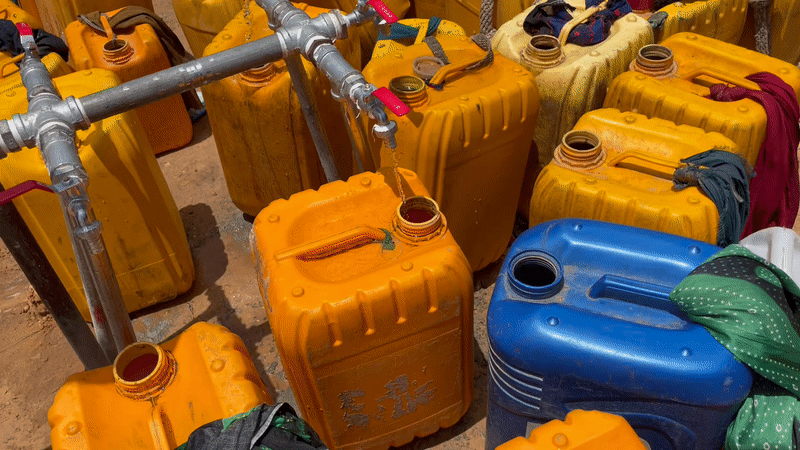
Camp residents fill up jerrycans with water that was trucked in.
Camp residents fill up jerrycans with water that was trucked in.
“We're doing all we can with our resources but those resources are a drop in the bucket,” McKenna said.
There’s a $482 million gap in the U.N. Office for the Coordination of Humanitarian Affairs response plan for Somalia. The United States provides the lion’s share of the existing funding — 70%, with the next highest contributor, the European Union, at only 6%.
“The response feels small in comparison to the absolute need,” McKenna said. “The cavalry hasn’t arrived.”
It's a slow and expensive response. Al-Shabab’s presence means goods and people must fly by plane around the country. Tensions between federal, state, and district authorities also mean humanitarians often must navigate multiple layers of bureaucracy.
With minimal domestic resources to draw from, Abdirahman Abdishakur, Somali president's envoy for drought response, said that the government is looking to countries in the Gulf and the Islamic Development Bank to scale up the response.
Responders are urging for immediate action even without an official famine declaration.
“Frankly, it doesn't matter what you call it. The reality is everyone needs to be here. There needs to be all hands on deck,” McKenna said.
Devex visited Keerey, the mother who lost two kids from starvation and measles, on a day it rained in the camps. While it seems counterintuitive, the rains can also be a curse. It’s the kind of rain that doesn’t ease the severity of the drought but is enough to turn the displacement camp into a sloshy mess, fueling the spread of illness. Mud cakes to your feet with each step.
The shelter she constructed is about six feet long (almost 2 meters), with a torn piece of foam caked in mud, serving as her bed. The roof doesn’t completely keep out the rain.
Besides her remaining children, she is alone in the camps, with no one to help her process her trauma. She collects firewood from the outskirts of Baidoa, which she sells at about 10 cents a bundle to feed her family. It terrifies her because men on drugs linger around the area where she collects wood.
And the months ahead are just as worrying as the months she left behind.
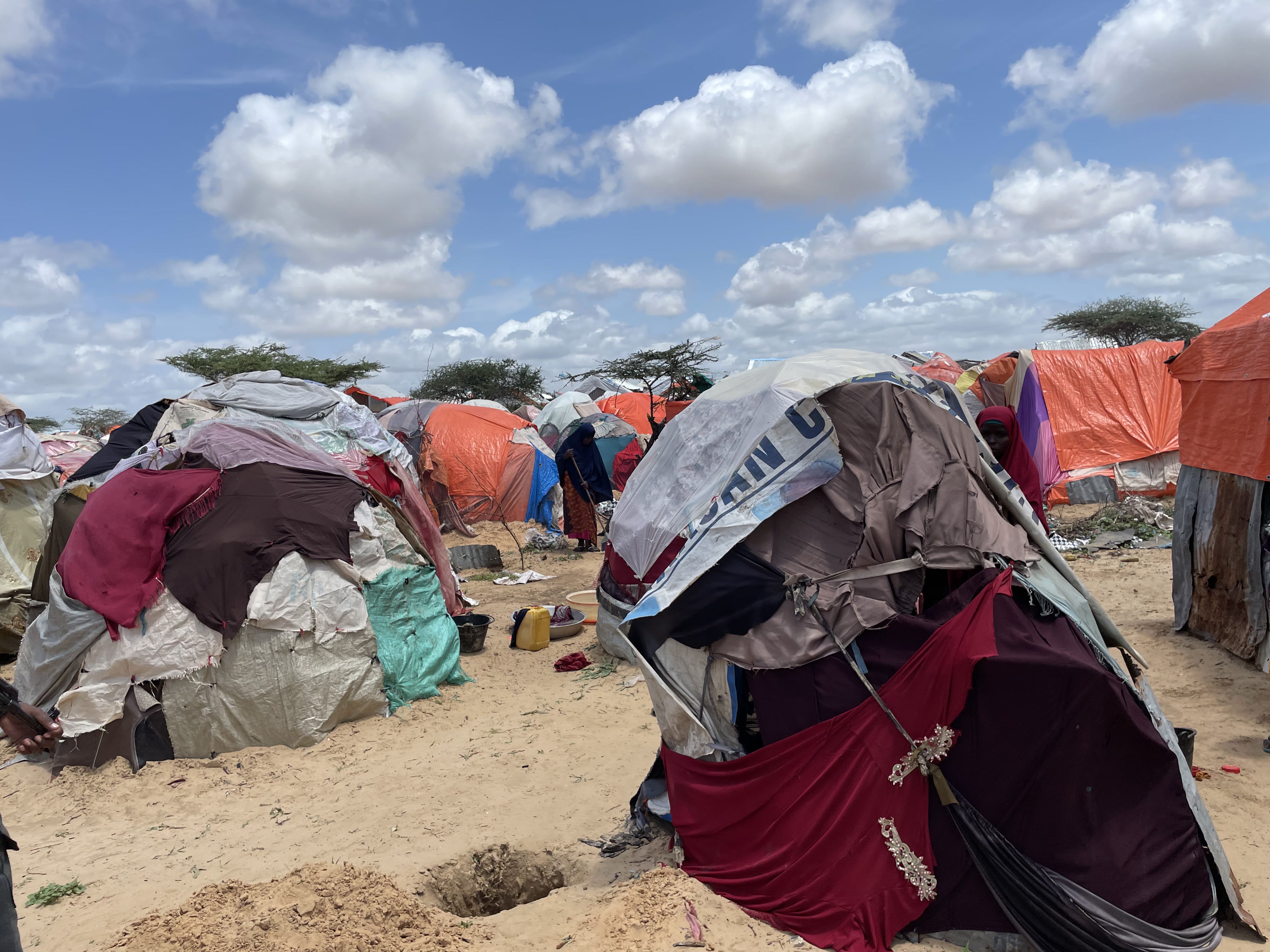
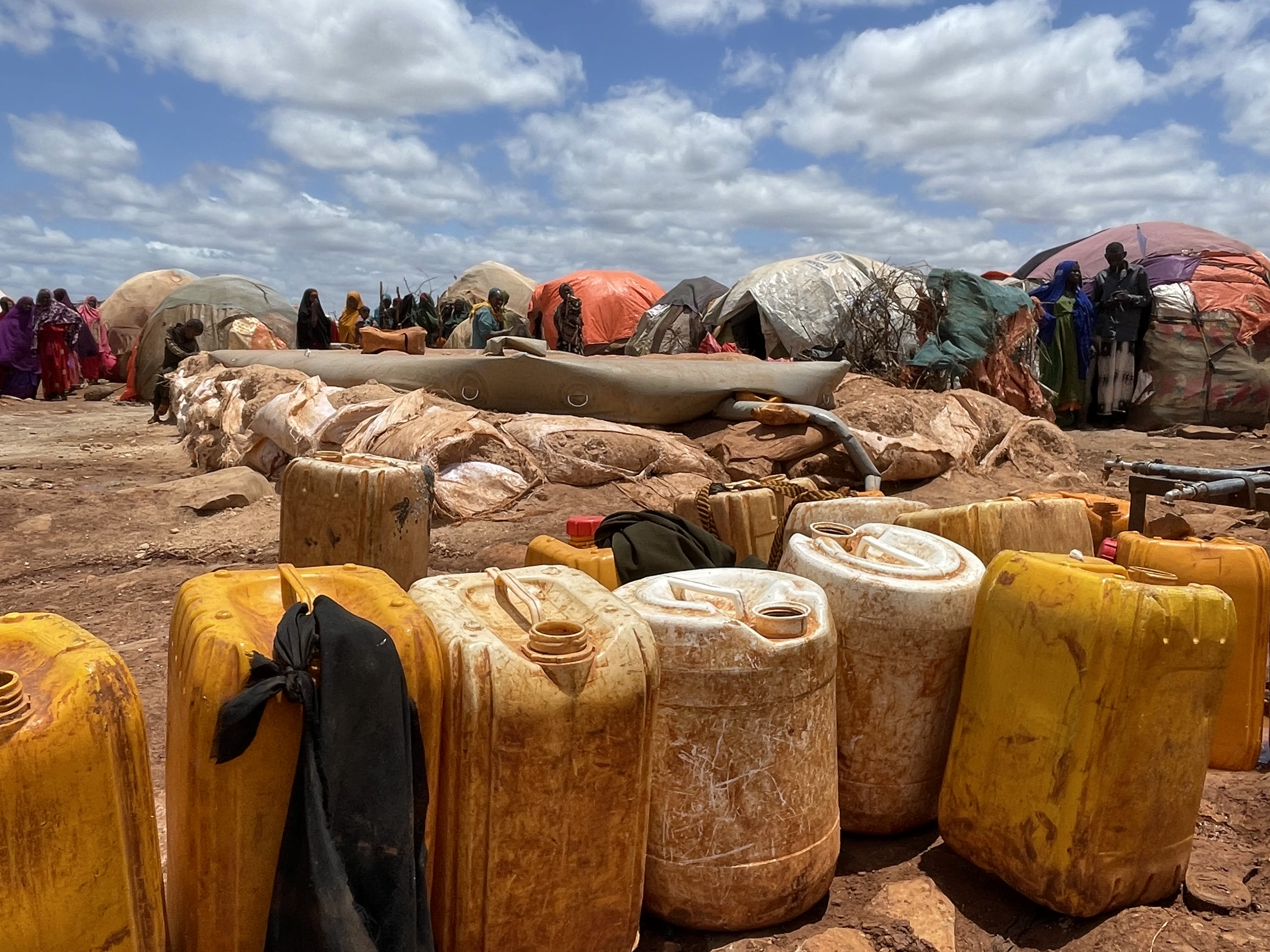

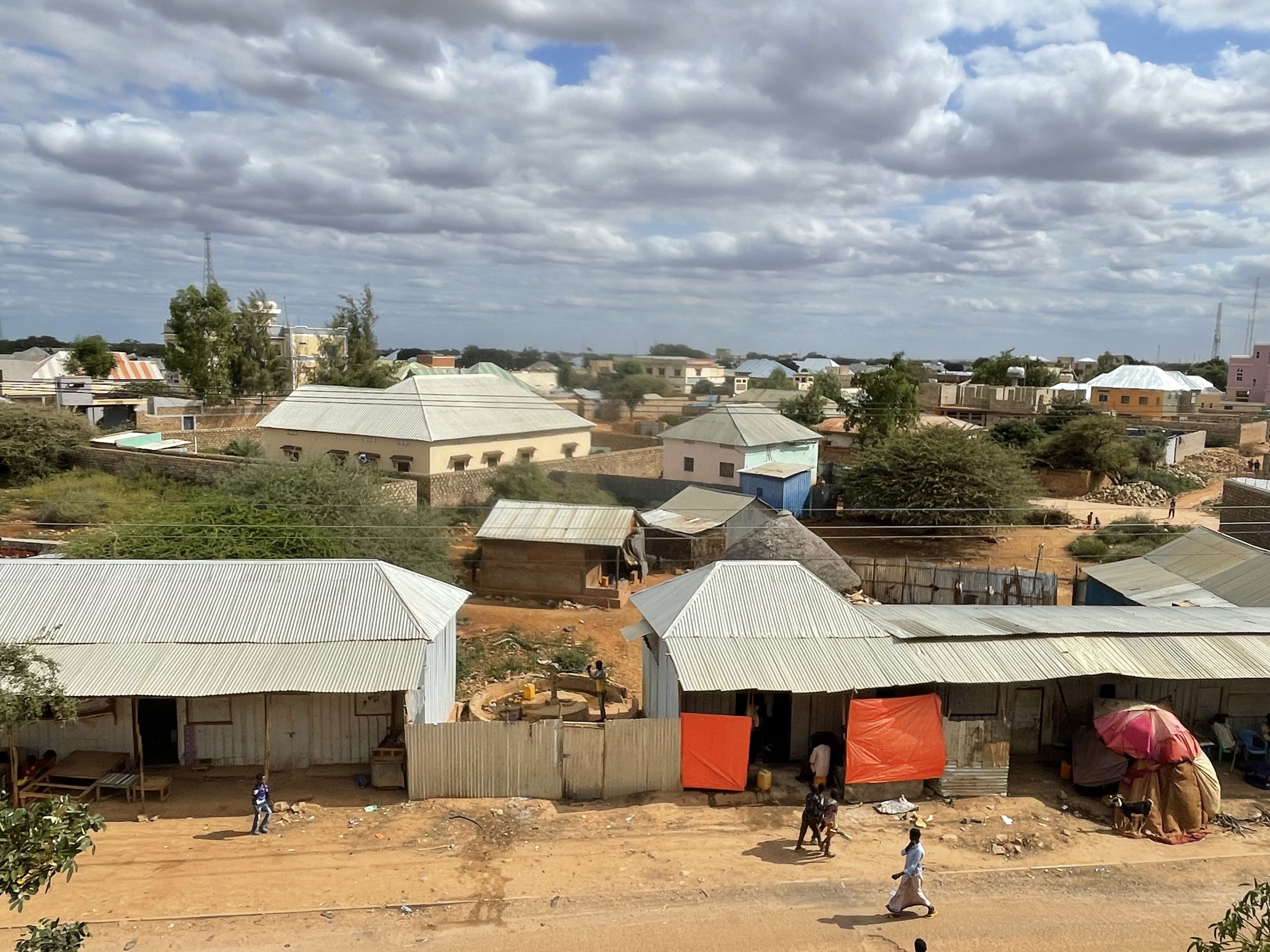

Tents at a displacement camp in Mogadishu, Somalia.
Tents at a displacement camp in Mogadishu, Somalia.

Jerrycans at a displacement camp in Baidoa.
Jerrycans at a displacement camp in Baidoa.

Water trucked into a camp in Baidoa.
Water trucked into a camp in Baidoa.

Streets of the city of Baidoa.
Streets of the city of Baidoa.
Note: Mercy Corps facilitated travel for this reporting. Devex retains full editorial independence.
Photos by: Sara Jerving
Produced by: Janelle Cruz
